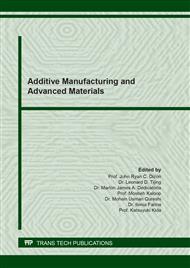p.27
p.35
p.45
p.59
p.79
p.87
p.99
p.107
p.119
Analysis on the Effects of 3D-Printed Bio-Propeller in Algal Nutrient Removal Efficiency and Biomass Production in a Laboratory-Scale Algal-Based Wastewater Treatment
Abstract:
Additive Manufacturing is an emerging technology used in wide applications including, wastewater treatment. This paper presents applied techniques of Additive Manufacturing in producing a 3D-printed prototype model of a laboratory-scale wastewater treatment process. This paper aims to show the efficiency of bioremediation of freshwater algae in reducing traces of phosphate and nitrates - both known pollutants responsible for eutrophication. The study also comparatively reviews two different set-ups: stagnant and aerated. 3D printed bio-propeller, a polylactic acid-based aerator, was applied to the latter aforementioned set-up and was designed to be durable, environmental oriented, and cost-efficient. Moreover, the features and details of the 3D-printed bio-propeller emphasized its ability to promote algae harvesting by acting as a sustainable biofilm for algal growth. It is found that both set-ups show significant algae bioremediation efficiency for the synthetic nutrients. Also, the aerated set-up indicated a favorable result with the highest efficiency of 92.857% for nitrates and 41.667% for phosphate. It is concluded that the potentials of 3D printed bio-propeller as a prime component of Rotating Biological Contractor (RBC) can promote sustainable wastewater treatment.
Info:
Periodical:
Pages:
79-85
Citation:
Online since:
March 2022
Price:
Сopyright:
© 2022 Trans Tech Publications Ltd. All Rights Reserved
Share:
Citation:


